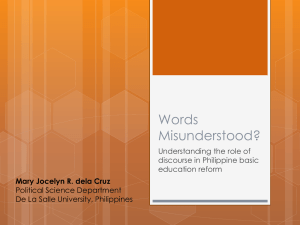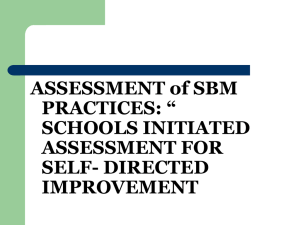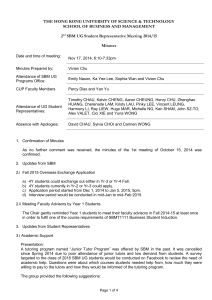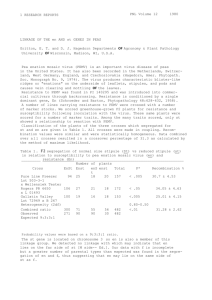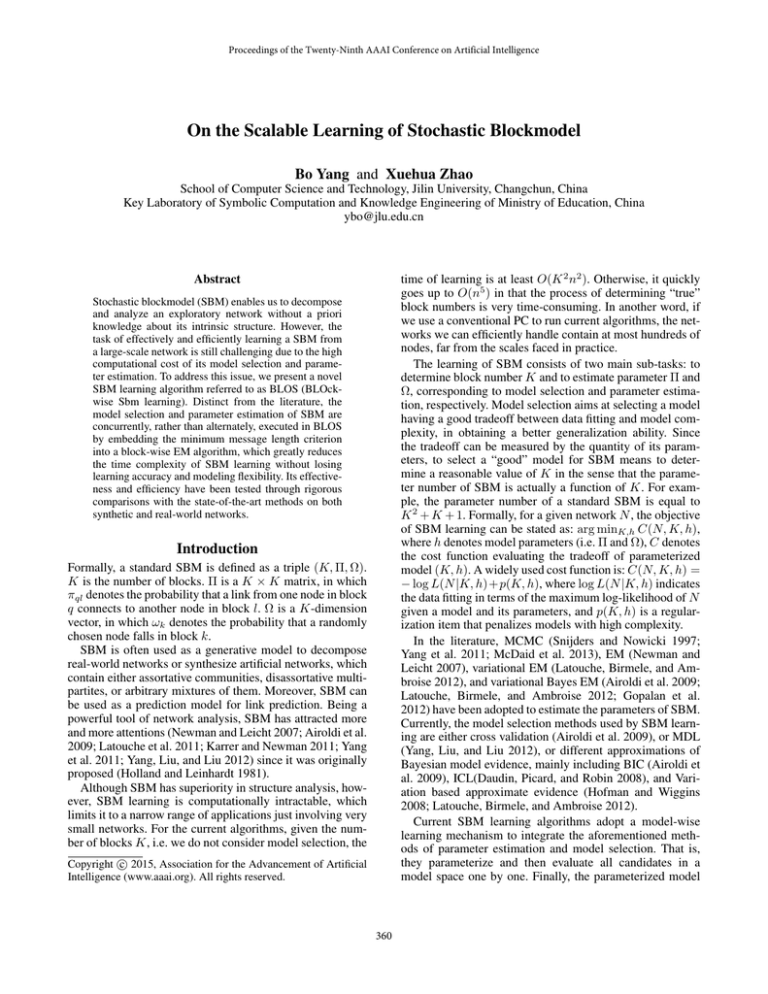
Proceedings of the Twenty-Ninth AAAI Conference on Artificial Intelligence
On the Scalable Learning of Stochastic Blockmodel
Bo Yang and Xuehua Zhao
School of Computer Science and Technology, Jilin University, Changchun, China
Key Laboratory of Symbolic Computation and Knowledge Engineering of Ministry of Education, China
ybo@jlu.edu.cn
time of learning is at least O(K 2 n2 ). Otherwise, it quickly
goes up to O(n5 ) in that the process of determining “true”
block numbers is very time-consuming. In another word, if
we use a conventional PC to run current algorithms, the networks we can efficiently handle contain at most hundreds of
nodes, far from the scales faced in practice.
The learning of SBM consists of two main sub-tasks: to
determine block number K and to estimate parameter Π and
Ω, corresponding to model selection and parameter estimation, respectively. Model selection aims at selecting a model
having a good tradeoff between data fitting and model complexity, in obtaining a better generalization ability. Since
the tradeoff can be measured by the quantity of its parameters, to select a “good” model for SBM means to determine a reasonable value of K in the sense that the parameter number of SBM is actually a function of K. For example, the parameter number of a standard SBM is equal to
K 2 + K + 1. Formally, for a given network N , the objective
of SBM learning can be stated as: arg minK,h C(N, K, h),
where h denotes model parameters (i.e. Π and Ω), C denotes
the cost function evaluating the tradeoff of parameterized
model (K, h). A widely used cost function is: C(N, K, h) =
− log L(N |K, h)+p(K, h), where log L(N |K, h) indicates
the data fitting in terms of the maximum log-likelihood of N
given a model and its parameters, and p(K, h) is a regularization item that penalizes models with high complexity.
In the literature, MCMC (Snijders and Nowicki 1997;
Yang et al. 2011; McDaid et al. 2013), EM (Newman and
Leicht 2007), variational EM (Latouche, Birmele, and Ambroise 2012), and variational Bayes EM (Airoldi et al. 2009;
Latouche, Birmele, and Ambroise 2012; Gopalan et al.
2012) have been adopted to estimate the parameters of SBM.
Currently, the model selection methods used by SBM learning are either cross validation (Airoldi et al. 2009), or MDL
(Yang, Liu, and Liu 2012), or different approximations of
Bayesian model evidence, mainly including BIC (Airoldi et
al. 2009), ICL(Daudin, Picard, and Robin 2008), and Variation based approximate evidence (Hofman and Wiggins
2008; Latouche, Birmele, and Ambroise 2012).
Current SBM learning algorithms adopt a model-wise
learning mechanism to integrate the aforementioned methods of parameter estimation and model selection. That is,
they parameterize and then evaluate all candidates in a
model space one by one. Finally, the parameterized model
Abstract
Stochastic blockmodel (SBM) enables us to decompose
and analyze an exploratory network without a priori
knowledge about its intrinsic structure. However, the
task of effectively and efficiently learning a SBM from
a large-scale network is still challenging due to the high
computational cost of its model selection and parameter estimation. To address this issue, we present a novel
SBM learning algorithm referred to as BLOS (BLOckwise Sbm learning). Distinct from the literature, the
model selection and parameter estimation of SBM are
concurrently, rather than alternately, executed in BLOS
by embedding the minimum message length criterion
into a block-wise EM algorithm, which greatly reduces
the time complexity of SBM learning without losing
learning accuracy and modeling flexibility. Its effectiveness and efficiency have been tested through rigorous
comparisons with the state-of-the-art methods on both
synthetic and real-world networks.
Introduction
Formally, a standard SBM is defined as a triple (K, Π, Ω).
K is the number of blocks. Π is a K × K matrix, in which
πql denotes the probability that a link from one node in block
q connects to another node in block l. Ω is a K-dimension
vector, in which ωk denotes the probability that a randomly
chosen node falls in block k.
SBM is often used as a generative model to decompose
real-world networks or synthesize artificial networks, which
contain either assortative communities, disassortative multipartites, or arbitrary mixtures of them. Moreover, SBM can
be used as a prediction model for link prediction. Being a
powerful tool of network analysis, SBM has attracted more
and more attentions (Newman and Leicht 2007; Airoldi et al.
2009; Latouche et al. 2011; Karrer and Newman 2011; Yang
et al. 2011; Yang, Liu, and Liu 2012) since it was originally
proposed (Holland and Leinhardt 1981).
Although SBM has superiority in structure analysis, however, SBM learning is computationally intractable, which
limits it to a narrow range of applications just involving very
small networks. For the current algorithms, given the number of blocks K, i.e. we do not consider model selection, the
c 2015, Association for the Advancement of Artificial
Copyright Intelligence (www.aaai.org). All rights reserved.
360
with the best evaluation is selected. Let [Kmin , Kmax ] denote a model space, the pseudo codes of model-wise learning mechanism can be described as follows:
the model selection and parameter estimation are executed
concurrently in the scale of blocks. In this way, it is expected
to greatly reduce the time complexity of SBM learning while
preserving its accuracy, which enables BLOS to efficiently
and effectively handel much larger networks. To the best of
our knowledge, this is the first effort in the literature to propose a block-wise SBM learning algorithm.
FOR K = Kmin : Kmax : 1
estimate h for a given K;
compute C(N, K, h);
(K, h)∗ = arg minK,h C(N, K, h).
Model and Method
For an exploratory network we usually have no idea about
its true block number, hence a complete model space [1, n]
should be exhaustively searched in order to safely find out
it. As a result, an extremely expensive computational cost
will be resulted by such a model-wise learning. For example,
if h is estimated by an EM-like algorithm, such as SILvb
(Latouche, Birmele, and Ambroise 2012), the entire time of
model-wise learning will be O(n5 ).
So far, how to significantly improve the scalability of
SBM learning while retaining its learning accuracy and
modeling flexibility, in order to properly handle large-scale
exploratory networks, is still an open problem. In this work,
we will address this problem from two new perspectives, and
accordingly our main contributions are twofold.
(1) To reduce the time complexity of parameter estimation
by presenting a new SBM model.
Note that, if one adopts EM-like algorithms to estimate
parameters, the calculation of Π is the most expensive and
dominates the entire time of parameter estimation. In view
of this, an indirect rather than direct way is suggested to perform the calculation of Π. In doing so, we first present a
new SBM model, referred to as fine-gained SBM (fg-SBM
for short), in which Π, a block-to-block connection matrix,
is replaced with Θ, a newly introduced block-to-node connection matrix, so that Θ is readily calculated with a much
fewer time while ensuring Π can be exactly represented in
terms of Θ together with other parameters. In this way, it
is expected to reduce the time of parameter estimation while
preserving the flexibility of block modeling. It is also important that, the posterior distribution of Z (the laten variable of
SBM) can be analytically derived from Θ, and thereby one
can directly calculate it by an exact EM instead of estimating
an approximate posterior via variational techniques. In what
follows, one will see how this feature enables us to derive a
much more efficient mechanism to learn SBM.
(2) To reduce the time complexity of model selection by
presenting a block-wise learning mechanism.
As mentioned above, current SBM learning algorithms
adopt a model-wise learning mechanism to integrate parameter estimation and model selection, in which the processes
of parameterizing and evaluating respective candidate models are completely independent of each other. Accordingly,
much of the information that could be shared with each
other has to be recalculated for each candidate, leading to a
very high computational cost. In view of this, we propose a
bock-wise learning algorithm named as BLOS (BLock-wise
Sbm learning) to efficiently learn the proposed fg-SBM. Instead of the “serial” learning mechanism adopted by current
SBMs, the proposed BLOS ingeniously integrates the minimum message length (MML) criterion into a block-wise EM
algorithm to achieve a “parallel” learning process, in which
The reparameterization of stochastic blockmodel
Let An×n be the adjacency matrix of a binary network
N containing n nodes. The fine-gained SBM (fg-SBM for
short) is defined as a triple X=(K, Θ, Ω). K is the number of blocks. Θ is a K × n block-node coupling matrix,
in which θkj depicts the probability of a node from block k
connecting to node j. Ω is still the prior of block assignment.
In addition, from N one can deduce a latent block indicator Z, a n × K matrix, indicating the relationship between
node and block assignment. zik = 1 if node i is assigned to
block k, otherwise zik = 0. It is easy to proof, in terms of
the reparameterized Θ, the block-block coupling matrix Π
in the standard SBM can be represented as Π = ΘZD−1 ,
−1
where D=block-diag{nω1−1 , · · · , nωK
}.
According to fg-SBM, one can generate a synthetic net
with a block structure by: 1) assigning a node to block k according to ωk ; 2) generating a link from node i to j according to the Bernoulli distribution with a parameter θkj , where
k indicates the block to which node i belongs. Accordingly,
the log-likelihood of a network to be generated is:
log p(N |X) =
n
X
log
i=1
K Y
n
X
(
f (θkj , aij ))ωk
(1)
k=1 j=1
where f (x, y) = xy (1 − x)(1−y) is a Bernoulli distribution.
Considering Z as a latent variable, then the log-likelihood
of complete data given a fg-SBM is:
logp(N,Z|X) =
K
n X
X
i=1 k=1
zik (
n
X
logf(θkj,aij )+logωk ) (2)
j=1
A block-wise SBM learning algorithm
In contrast to the model-wise mechanism adopted by current
SBM learning, we provide a block-wise learning mechanism
to concurrently perform parameter estimation and model selection, described as follows:
Initialize block candidate set: B = {b1 , · · · , bKmax };
REPEAT
FOR ∀b ∈ B DO
evaluate block b;
IF b is good enough
parameterize b ;
ELSE
B ← B − {b};
compute C(N, B, h), the cost of current model;
UNTIL C is convergent or kBk < Kmin ;
In the framework, candidates in the scale of blocks, rather
than in the scale of full models, are parameterized and evaluated in turn. The processes of handling respective candidate
361
Accordingly, we have:
blocks are dependent. The information obtained from the parameterization and evaluation of one block can be instantly
used for handling next blocks, which will avoid a great deal
of duplicated calculations in the whole process of learning.
Moreover, during the course of block-wise learning, only the
blocks that are evaluated as good enough will be further considered to estimate their parameters. Otherwise, they will be
removed from candidate set and not considered anymore.
To implement the framework, we integrate MML into a
block-wise EM algorithm to evaluate and parameterize each
block, respectively. We choose MML as an evaluation criterion mainly because MML sufficiently considers the prior
of models, and more importantly as we can see next, such a
prior enables MML to be readily integrated into the above
block-wise learning framework.
|Ic (XS )| = n2K
+
K Y
K
Y
q=1 l=1
ωq ωl
πql (1 − πql )
(4)
q=1 l=1
(
K
Q
− 21
ωk )
and p(πql ) ∝
p
1
|I(πql )| = (πql (1 − πql ))− 2 .
k=1
Based on above analysis, overall we have:
K
C(N, XS ) = − log p(N |XS ) +
K
1 XX
log ωq ωl
2 q=1
l=1
(5)
2
2
K +K
2K + K
log n +
(1 + log κd )
2
2
Now let us connect two SBMs, i.e., XS and X. Note that:
1) Π can be represented as ΘZD−1 ; and 2) Z is independent
on Π and Θ given KP
and Ω, respectively. So, we have:
log p(N |XS ) = log P Z p(N, Z|K, Π, Ω)
= log PZ p(N |Z, K, Π, Ω)p(Z|K, Ω)
= log PZ p(N |Z, K, ΘZD−1 , Ω)p(Z|K, Ω)
= log Z p(N, Z|K, Θ, Ω)
= log p(N |K, Θ, Ω) = log p(N |X).
In addition, we have: 1) K and Ω in XS and X are the
same, and 2) the parameters of zero-probability block (i.e.
ωk = 0) will not make any contribution to total code-length.
Let Kg ≤ K be the number of greater-than-zero probability
blocks, then Eq. 5 becomes:
1 X X
log ωq ωl
C(N, X) = − log p(N |X) +
2 ω >0 ω >0
q
l
(6)
2Kg2 + Kg
Kg2 + Kg
+
log n +
(1 + log κd )
2
2
Optimization method According to information theory,
the cost in terms of Eq. 6 is the sum of code-length of data,
denoted by the minus likelihood − log p(N |X), and codelength of model, denoted by the remaining part. While, from
Bayesian point, the minus of Eq. 6 can be regarded as the
posteriori of X, log p(X|N ), which is P
the P
sum of a loglikelihood log p(N |X) and a priori − 21 q l log ωq ωl −
+
zik log ωk
i=1 k=1
n X
n X
K X
K
X
ωk−1
We use a noninformative prior to depict the lack of
knowledge about model parameters, in which the prior
of Ω and Π are independent and the priori of respective
πql are also independent. Specifically, we have: p(XS ) =
K Q
K
p
Q
p(ω1 , ..., ωk )
p(πql ), p(ω1 , ..., ωk ) ∝
|I(Ω)| =
C(N, X) = − log p(N |X) − log p(X)
(3)
1
d
+ log |I(X)| + (1 + log κd )
2
2
where d is dimension of X (i.e. the number of parameters
2
log p(N |X)] is the Fisher inforof X), I(X) ≡ −E[DX
mation matrix and |I(X)| denotes its determinant, and κd
approaches (2πe)−1 as d grows.
We start our derivation from a standard SBM, denoted as
XS = (K, Π, Ω). Since it is not easy to analytically get
I(XS ), we turn to the Fisher information matrix of com2
plete data likelihood, Ic (XS ) ≡ −E[DX
log p(N, Z|XS )],
S
which is the upper-bound of I(XS ) (Titterington et al.
1985). The log-likelihood of complete data given a XS is:
log p(N, Z|XS ) =
K
Y
+K
k=1
The derivation of cost function Given N , we expect to
select an optimal X from its model space to properly fit
and to precisely predict the behaviors of the network. According to the MAP principle (maximum a posteriori), the
optimal X given network N will be the one with the maximum posterior probability. Moreover, we have: p(X|N ) ∝
p(N |X)p(X), where p(X|N ), p(N |X) and p(X) denote
the posteriori of X given N , the likelihood of N given X,
and the prior of X, respectively. Next, we will derive the
form of log p(X|N ), i.e. the cost function C(N, X), from
an integration of MML, standard SBM and fg-SBM.
MML selects models by minimizing the code-length of
both data and model. Formally, the cost function of MML is
(Lanterman 2001; Figueiredo and Jain 2002):
n X
K
X
2
2Kg2 +Kg
2
K 2 +Kg
log n − g 2 (1 + log κd ). It means to minimize
Eq. 6 is to maximize the posteriori. Next, we use a standard
EM to estimate an optimal X by maximizing log p(X|N ).
Its E-step and M-step are designed respectively as follows.
E-step: Given N , K, and h(t−1) , where h and t respectively denote the parameters (Θ, Ω) and the current iteration, to compute the conditional expectation of complete
log-likelihood, i.e., the Q-function.
a
ziq zil log πqlij (1 − πql )1−aij
i=1 j=1 q=1 l=1
From the log-likelihood, Ic (XS ) is derived as:
−1
Ic (XS ) = block-diag{nω1−1 , . . . , nωK
,
n2 ω1 ω1
n2 ω1 ωK
,...,
,...,
π11 (1 − π11 )
π1K (1 − π1K )
n2 ωK ω1
n2 ωK ωK
,...,
}
πK1 (1 − πK1 )
πKK (1 − πKK )
Q(h,h(t−1) ) =
n X
K
X
n
X
γik( logf(θkj,aij )+log ωk )
i=1 k=1
362
j=1
(7)
where γik = E[zik ; h(t−1) ] denotes the posteriori probability of node i belonging to block k given h(t−1) . We have:
(t−1) Qn
(t−1)
ωk
, aij )
j=1 f (θkj
γik = PK
(8)
(t−1) Qn
(t−1)
, aij )
k=1 ωk
j=1 f (θkj
Table 1: The implementation of block-wise SBM learning
Algorithm BLOS
Input: N , Kmin , Kmax
Output: X and Z
01 Initial: B = {b1 , ..., bKmax }; t ← 0; Kg ← Kmax ; ε; Θ(0) ;
Q
(0)
(0)
02 Ω(0) ; uik ← n
j=1 f (θkj , aij ), for i = 1, ..., n and ∀bk ∈ B;
03 REPEAT
04
t ← t + 1;
05
FOR ∀bk ∈ B DO
M-step: To maximize Q(h, h(t−1) )+ log p(h), where
P P
2Kg2 +Kg
log n −
log p(h) = − 12
log ωq ωl −
2
ωq >0 ωl >0
Kg2 +Kg
(1+log κd ). By solving this optimization with a con2 P
K
straint k=1 ωk = 1, we have:
P
max{0, n
(t)
i=1 γik −Kg }
ω
=
k
K
P
P
max{0, n
i=1 γij −Kg }
(9)
j=1
P
n
a
γ
(t)
ij
ik
i=1
θ = Pn
kj
i=1 γik
06
07
08
09
10
Note that, the parameter Π of standard SBM can also be
iteratively computed in terms of γ, as follows:
P P
i
j γip γjl aij
πpl = P P
(10)
i
j γip γjl
11
(t−1) (t−1)
ω
u
k
ik
, for i = 1, ..., n;
P
(t−1) (t−1)
u
bj ∈B ωj
ij
Pn
(t)
max{0, i=1 γ
−Kg }
(t)
ik
ωk ← P
;
Pn
(t)
bj ∈B max{0, i=1 γij −Kg }
P
(t)
S←
bj ∈B ωj ;
(t) −1
(t)
ωj ← ωj S , ∀bj ∈ B;
(t)
IF ωk > 0 THEN
Pn
(t)
(t)
i=1 aij γik
θki ← P
, for i = 1, ..., n;
(t)
n
γ
Qni=1 ik(t)
(t)
uik ← j=1 f (θkj , aij ), for i = 1, ..., n;
(t)
γik ←
12
13
ELSE
14
Kg ← Kg − 1;
15
B ← B − {bk };
16
ENDIF
17
ENDFOR
18
X (t) ← {Kg , Θ(t) , Ω(t) };
19
compute C(N, X (t) ) by Eq. 6;
20 UNTIL |C(N, X (t−1) ) − C(N, X (t) )| < ε or Kg < Kmin ;
21 X ← X (t) ;
It is easy to verify, the complexity of calculating Θ of fgSBM according to Eq.9 is O(Kn2 ), yet the time of calculating Π according to Eq.10 is O(K 2 n2 ).
Since the prior of block assignment Ω characterizes the
normalized distribution of block size, the calculation of ωk
in Eq.9 partially reflect the process of block-wise model selection, in which blocks being not sufficiently supported by
data will be annihilated timely. More specifically, for each
individual block k, ωk will become and
keep zero
Pthereafter
n
if its expectation size at present, i.e. i=1 γik , is less than
the number of existing blocks.
If one considers such a model selection as a voting game,
Eq.9 actually implies a new mechanism design particularly
for SBM learning according to MML, in which candidates
will be disqualified and then timely excluded from the current playoff of the game if the votes they have won from all
nodes are less than the total number of existing candidate
blocks. Note that, the threshold for qualifying individual
blocks, i.e. Kg , is not fixed but self-adjusted during whole
learning process. That is to say, the regulations of threshold at different stages will be self-adaptive to the block parameterization (in terms of the calculation of Θ and Γ) and
block evaluation (in terms of the calculation of Ω) of both
previous and current playoffs. The self-adaption of evaluating criterion is one of main features of block-wise SBM
learning. In addition, the criterions at different stages will
be evolving from strict to loose with the gradual reduction
of candidates during playoffs, implying many trivial blocks
will be removed as early as possible and thereby considerable computational cost of corresponding parameterization
will be saved in this way.
Time complexity analysis The nested REPEAT and FOR
loops are the most time-consuming in BLOS, which dominate the whole time of learning. In the body of FORloop, it takes O(nKg ) time to calculate γ·k in line 06 and
ωk in line 07, respectively, and takes O(n2 ) time to calculate θk· in line 11 and u·k in line 12, respectively. Ac(t+1)
(t) (t)
)
cordingly, the FOR-loop takes O(nKg Kg + n2 Kg
(t)
time, where Kg denotes the size of set B at the t-th
iteration of REPEAT-loop. Cost computation in line 19
(t+1) 2
(t+1)
) ) time. So, it will take
+ (Kg
takes O(n2 Kg
(t)
(t+1) 2
(t+1)
(t) (t)
) ) < O(n2 Kg ) time
+ (Kg
O(nKg Kg + n2 Kg
to perform the t-th REPEAT-loop. Thus, the complexity of
PT
(t)
REPEAT-loop is O( t=1 n2 Kg ), where T is number of
(0)
total iterations. Note that, the initialization of all uik takes
2
O(n Kmax ) time, so the total time complexity of BLOS is
PT
(t)
(t)
O( t=1 n2 Kg + n2 Kmax ). Since Kg ≤ Kmax , in the
worst case, the time of BLOS is bounded by O(T n2 Kmax ).
If the real number of blocks (say K) is known, the worst
time of BLOS is O(T n2 K) by initializing Kmax = K. Otherwise, it will be O(T n3 ) by initializing Kmax = O(n).
Validations
The mechanism of block-wise SBM learning Based on
the above analysis, Table 1 summarizes the detailed mechanism of block-wise SBM learning. Corresponding to the
aforementioned framework, the evaluation, selection, parameterization and annihilation of blocks are performed in
a block-wise mode within a FOR-loop.
Next, we design experiments oriented toward evaluating the
accuracy, the scalability, and the tradeoff between accuracy
and scalability of BLOS. In order to sufficiently demonstrate
the superiority of BLOS, Four state-of-the-art SBM learning
methods, VBMOD (Hofman and Wiggins 2008), GSMDL
363
(Yang, Liu, and Liu 2012), SICL (Daudin, Picard, and Robin
2008) and SILvb (Latouche, Birmele, and Ambroise 2012),
are selected as comparative methods, whose rationale and
time complexity are summarized in Table 2. All experiments
are performed on a conventional personal computer with a
2GH CPU and a 4GB RAM.
3, in which the numbers in brackets on the right hand side
show the ranks in terms of decreasing average NMI, indicating the accuracy rank of tested algorithms on average. For
networks of Type I, SILvb and VBMOD perform slightly
better than other algorithms. For networks of Type II and
III, SILvb and BLOS perform better than others. VBMOD
is stable for community detection, but it fails to handle networks containing beyond community structures.
Table 2: Time complexity of SBM learning algorithms
Algorithm
BLOS
VBMOD
GSMDL
SICL
SILvb
Parameter
estimation
BEM
VBEM
EM
VEM
VBEM
Validation on computational scalability Next, we use
synthetic networks with various scales to test the computing cost of different algorithms. Here, synthetic networks to
be used are also generated according to the SBM of Type III.
Specifically, its parameters are: Ktrue = 8, k1 = 3, k2 = 5
and ∀k : ωk = 0.125. n alternatively takes 200, 400, 600,
800, 1000, 2000, 5000, 10000, and 15000. In the case of
n < 5000, we set p1 = 0.5 and p2 = 0.01. Otherwise, we
set p1 = 0.1 and p2 = 0.0001. Correspondingly, we generate nine groups of networks with different scales and each
group contains 50 randomly generated networks.
For all five algorithms, we set the same model space to
search and the same convergence threshold, i.e., Kmin = 1,
Kmax = 20 and ε = 10−4 . Fig. 1 shows the actual running
time on average of five algorithms. Table 4 shows the NMI of
detected block structures for these networks, in which “−”
denotes “not available due to out of memory”.
Model Learning
K
N/K
selection strategy
MML
B
O(T Kn2 ) O(T n3 )
VAE
M
O(T Kn2 ) O(T n4 )
MDL
M
O(T K 2 n2 ) O(T n5 )
ICL
M
O(T K 2 n2 ) O(T n5 )
VAE
M
O(T K 2 n2 ) O(T n5 )
In Table 2, K is the real number of blocks and T is the required iterations. “BEM”, “VBEM”, “VEM” mean “blockwise EM”, “variational Bayes EM”, “variational EM”, respectively. “B” and “M” mean “block-wise” and “modelwise”, respectively. “VAE” is the abbreviation of variational
based approximate evidence. “K” and “N/K” indicate “K is
known ” and “K is unknown”, respectively. In both cases,
we list the worst time complexity of respective algorithms.
Validation on accuracy We first generate three types of
synthetic networks according to specific SBMs, which respectively contain a community structure, a hub structure,
and a hybrid structure of community and multipartite. Each
type of networks is further divided into five groups according to the true block number they contain, i.e., Ktrue = 3,
4, 5, 6 or 7. Each group has 100 networks and each network
contains 50 nodes. The parameters of three types of SBMs
are given as follows:
Type I, containing a community structure: πij = 0.9 ×
I(i = j) + 0.1 × I(i 6= j) and ∀k : ωk = 1/Ktrue .
Type II, containing a hub structure: πij = 0.9 × I(i = j
or i = 1 or j = 1) + 0.1 × I(i 6= j and i, j 6= 1) and
∀k : ωk = 1/Ktrue .
Type III, containing a hybrid structure of community and
multipartite: ∀k, ωk = 1/Ktrue and block matrix Π takes
following form:
)
p1
p2 ·
k1
..
.
·
p2
p 2
p1 ·
·
· · ·
·
·
Π=·
p
· p2
1 )
.
k2
..
p2
·
· p1
p2
Figure 1: Running time in terms of network scale.
Overall, we have following observations: 1) BLOS runs
the most efficient and its actual running time is significantly fewer than its competitors. 2) It is computationally intractable for model-wise methods such as SILvb and SICL to
process large networks. Note that, SILvb needs to take 5834
seconds to handle 1000 nodes, and the time will sharply increase to 100,788 seconds (28 hours) when handling 2000
nodes. Comparatively, BLOS runs much faster and is able to
handle 2000 nodes within 12 seconds, gaining a 8400-fold
speedup of SILvb. SICL spends 216,893 seconds (60 hours)
to handle 5000 nodes; BLOS only takes 46 seconds to handle the same network, gaining a 4700-fold speedup. 3) VBMOD adopts a model-wise scheme to learn SBM as well,
while it runs much faster than SILvb, SICL and GSMDL.
But VBMOD achieves its scalability by greatly simplifying
SBM to be learned, i.e. compressing original K × K matrix
Π into two scalar variables, at the price of losing the flexibility of modeling heterogeneous structures. 4) From Fig. 1 and
Table 4, one can observe the best tradeoff between accuracy
where k1 and k2 denote the number of communities and
multipartite components, respectively. We have k1 + k2 =
Ktrue . When Ktrue takes 3, 4, 5, 6 and 7 in turn, k1 takes
1, 2, 3, 3 and 3, accordingly. In this experiment, we set
p1 = 0.9 and p2 = 0.1.
For each type of block structure, we calculate the average NMI(normalized mutual information) over 100 synthetic networks for each algorithm; results are given in Table
364
Table 3: Accuracy of detected block structures in three types of networks
Networks of Type I
Ktrue
3
4
5
6
7
BLOS
1
1
1 0.951 0.877
1 0.894 0.783
GSMDL 0.998 1
VBMOD 1
1
1
1 0.861
SICL
1
1
1 0.940 0.837
SILvb
1
1
1 0.999 0.947
Methods
Average
0.966(3)
0.935(5)
0.972(2)
0.955(4)
0.989(1)
Networks of Type II
Ktrue
3
4
5
6
7
0.997 1
1 0.950 0.868
0.985 0.994 1 0.889 0.788
0.592 0.771 0.851 0.850 0.837
1
1
1 0.944 0.855
1
1
1 0.999 0.951
and scalability demonstrated by BLOS. That is, compared
with state-of-the-art algorithms, BLOS is able to effectively
and efficiently handle much larger networks while preserving rather good learning precision.
Table 6: Actual running time in real-world networks (s)
Networks Kmax
Karate
n/2
Dolphins
n/2
Foodweb
n/2
Polbooks
n/2
Adjnoun
n/2
Football
n/2
Email
100
Polblogs
100
Yeast
100
Table 4: NMI of detections by five algorithms
Number of nodes BLOS GSMDL VBMOD SICL
200
1
0.996
0.890
1
400
1
0.989
0.890
1
600
1
0.937
0.890
1
800
1
0.933
0.890
1
1000
1
0.924
0.890
1
2000
1
0.913
0.890
1
5000
1
0.890
0.890
1
10000
0.955
–
0.890
–
15000
0.940
–
0.890
–
SILvb
1
1
1
1
1
1
–
–
–
Networks Ktrue BLOS
Karate
2 0.839/3
Dolphins 2 0.660/3
Foodweb 5 0.269/4
Polbooks 3 0.585/4
Adjnoun 2 0.206/5
Football 12 0.884/10
avg(rank)
0.574(1)
SICL
0.34
4.08
4.92
36.80
40.08
42.14
35288
44834
>48h
SILvb
0.42
2.03
2.31
12.76
16.34
18.11
78597
106034
>48h
GSMDL
0.754/4
0.551/4
0.185/5
0.469/6
0.193/8
0.824/10
0.496(2)
VBMOD
0.837/2
0.628/4
0.023/2
0.512/6
0.020/5
0.862/9
0.480(3)
SICL
0.792/4
0.368/3
0.199/2
0.458/5
0.040/3
0.910/10
0.461(5)
SILvb
0.770/4
0.387/3
0.201/2
0.455/5
0.046/3
0.910/10
0.461(4)
Conclusion
Current SBMs face two main difficulties, which jointly make
their learning processes not scalable. (1) Some parameters
like Π cannot be estimated in an efficient way; (2) the posterior of Z cannot be explicitly derived due to the dependency
of its components. Therefore, one has to assume an approximate distribution of Z and then turn to variational techniques. While, it is difficult to integrate variational methods
with current model evaluation criteria to analytically derive a
block-wise learning mechanism, enabling to perform parameter estimation and model selection concurrently. In view of
this, we raised a reparameterized SBM and then theoretically
derived a bock-wise learning algorithm, in which parameter
estimation and model selection are executed concurrently in
the scale of blocks. Validations show that BLOS achieves
the best tradeoff between effectiveness and efficiency. Particularly, compared to SILvb, a recently proposed method
with an excellent learning accuracy, BLOS achieves a n2 fold speedup, reducing learning time from O(n5 ) to O(n3 ),
while preserving competitive enough learning accuracy.
Table 5: Structural features of 12 real-world networks
Karate
Dolphins
Foodweb
Polbooks
Adjnoun
Football
Email
Polblogs
Yeast
BLOS GSMDL VBMOD
0.13
0.23
0.19
0.32
1.55
0.45
0.33
1.60
0.53
0.96
8.06
2.02
1.10
8.09
2.12
1.20
8.11
2.20
41.09 18575
389
43.82 26031
618
104
>48h
1677
Table 7: NMI of detections by five algorithms
Validation on real-world networks Now we test the performance of algorithms with real-world networks. Total 9
real-world networks are selected, which are widely used as
benchmarks to validate the performance of block structure
detection or scalability. The structural features of these networks are summarized in Table 5. Some have ground truth
block structures. “–” means ground truth is not available.
Network
Average
0.963(2)
0.931(4)
0.780(5)
0.960(3)
0.990(1)
Networks of Type III
Ktrue
3
4
5
6
7 Average
1
1
1 0.978 0.878 0.971(2)
0.989 1
1 0.946 0.851 0.957(4)
0.764 0.863 0.742 0.811 0.780 0.792(5)
1
1
1 0.981 0.850 0.966(3)
1
1
1
1 0.941 0.988(1)
Type
# of # of Clustering Average Structure
node edge coefficient degree
Undirected 34 78
0.57
4.59 community
Undirected 62 159
0.26
5.13 community
Undirected 75 113
0.33
3.01
hybrid
Undirected 105 441
0.49
8.40 community
Undirected 112 425
0.17
7.59
bipartite
Undirected 115 613
0.40
10.7 community
Undirected 1133 5451
0.22
9.62
–
Directed 1222 16714 0.32
27.4
–
Undirected 2224 6609
0.13
5.94
–
For each algorithm, we fix Kmin = 1 and set Kmax according to Table 6. One can see the running time of BLOS is
significantly lower than others, particularly for larger networks. For networks having ground truth, the true block
numbers are listed below ”Ktrue ” in Table 7, and the detected numbers by algorithms are listed behind “/”. We adopt
NMI to measure the distance between ground truth and detections of algorithms. The last line gives the ranks of respective algorithms in terms of average NMI. BLOS performs the best when processing such real-world networks.
Acknowledgements
This work was funded by the Program for New Century Excellent Talents in University under Grant NCET-11-0204,
365
Yang, B.; Liu, J.; and Liu, D. 2012. Characterizing and extracting multiplex patterns in complex networks. Systems,
Man, and Cybernetics, Part B: Cybernetics, IEEE Transactions on 42(2):469–481.
and the National Science Foundation of China under Grants
61133011, 61373053, and 61300146.
References
Airoldi, E. M.; Blei, D. M.; Fienberg, S. E.; and Xing, E. P.
2009. Mixed membership stochastic blockmodels. In Advances in Neural Information Processing Systems, 33–40.
Daudin, J.-J.; Picard, F.; and Robin, S. 2008. A mixture model for random graphs. Statistics and computing
18(2):173–183.
Figueiredo, M. A., and Jain, A. K. 2002. Unsupervised
learning of finite mixture models. Pattern Analysis and Machine Intelligence, IEEE Transactions on 24(3):381–396.
Gopalan, P.; Gerrish, S.; Freedman, M.; Blei, D. M.; and
Mimno, D. M. 2012. Scalable inference of overlapping
communities. In Advances in Neural Information Processing Systems, 2249–2257.
Hofman, J. M., and Wiggins, C. H. 2008. Bayesian
approach to network modularity. Physical review letters
100(25):258701.
Holland, P. W., and Leinhardt, S. 1981. An exponential family of probability distributions for directed graphs. Journal
of the american Statistical association 76(373):33–50.
Karrer, B., and Newman, M. E. 2011. Stochastic blockmodels and community structure in networks. Physical Review
E 83(1):016107.
Lanterman, A. D. 2001. Schwarz, wallace, and rissanen:
Intertwining themes in theories of model selection. International Statistical Review 69(2):185–212.
Latouche, P.; Birmelé, E.; Ambroise, C.; et al. 2011. Overlapping stochastic block models with application to the
french political blogosphere. The Annals of Applied Statistics 5(1):309–336.
Latouche, P.; Birmele, E.; and Ambroise, C.
2012.
Variational bayesian inference and complexity control for
stochastic block models. Statistical Modelling 12(1):93–
115.
McDaid, A. F.; Murphy, T. B.; Friel, N.; and Hurley, N. J.
2013. Improved bayesian inference for the stochastic block
model with application to large networks. Computational
Statistics & Data Analysis 60:12–31.
Newman, M. E., and Leicht, E. A. 2007. Mixture models
and exploratory analysis in networks. Proceedings of the
National Academy of Sciences 104(23):9564–9569.
Snijders, T. A., and Nowicki, K. 1997. Estimation and
prediction for stochastic blockmodels for graphs with latent
block structure. Journal of classification 14(1):75–100.
Titterington, D. M.; Smith, A. F.; Makov, U. E.; et al. 1985.
Statistical analysis of finite mixture distributions, volume 7.
Wiley New York.
Yang, T.; Chi, Y.; Zhu, S.; Gong, Y.; and Jin, R. 2011. Detecting communities and their evolutions in dynamic social
networksa bayesian approach. Machine learning 82(2):157–
189.
366



